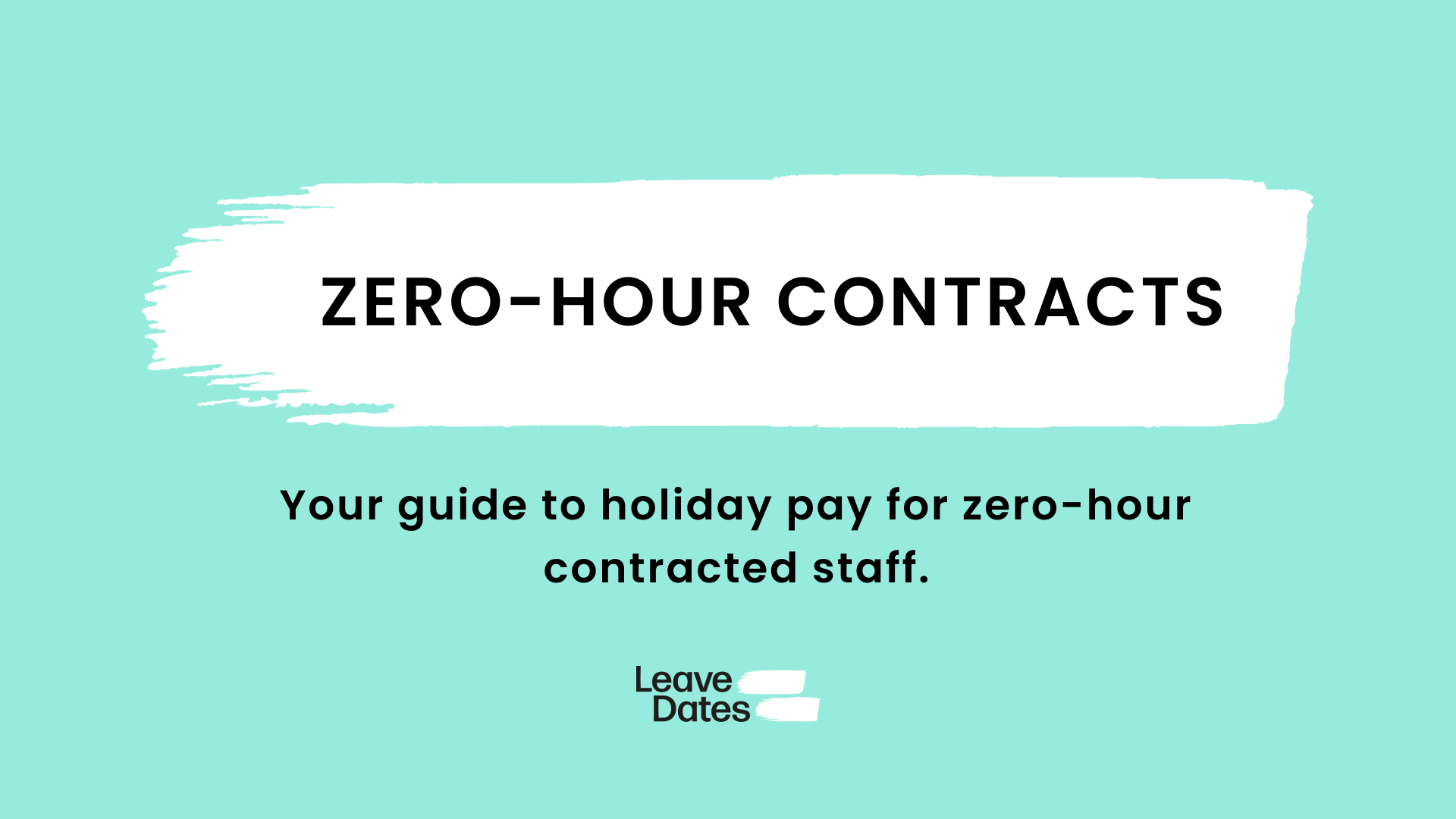
The times, they are a changing. And don’t employers just know it. With recent laws around flexible working hours expanding, each new generation of workers has increasingly high expectations when it comes to when and how they work. One of the new models that has come to the fore is annualised hours.
Scratching your head? Don’t worry, we’ve got you. While it might sound like a policy of working every hour under the sun for a full year (no thanks), it’s pretty much the opposite.
Table of contents
- So, what are annualised hours?
- Where did the idea come from?
- How do you calculate annualised hours?
- Benefits of annualised hours
- Potential issues
- Key takeaways
So, what are annualised hours?
It’s a kind of employment contract where the employer sets a target number of hours to be worked over the year (we’ll look at the maths later), with flexibility around when. Salary is based on the total number of hours the person is contracted to work per year, rather than per week or month. There may or may not be “core” hours they have to work each week, with the rest worked flexibly, based on demand or desire.
Annualised hours contracts are the chameleons of the working world. A nifty arrangement that runs laps around more typical ‘flexible working’ models, and seems to allow for what is, and will always be, the ideal work pattern: work when it rains, take the day off when it’s sunny. (This works out better for workers in Swansea than in California.)
Sound too good to be true? Well, maybe. It might just be a case of having more realistic (and, ahem, reasonable) expectations about. Ultimately, if you’re a professional elf but you want to take December off, Santa won’t be thrilled. Let’s get into the nitty gritty and see how it works, and who it works for.
Where did the idea come from?
Born out of a need for flexibility in the ever-changing world of work, and supported by rapidly evolving tech, the idea of annualised hours emerged as a solution to the rigid limits of the traditional 9–5. First used in industries with seasonal ebbs and flows (tourism, retail, manufacturing), it has value as an agile approach to workforce management that can be used far more widely.
Today, annualised hours contracts have broken through industry boundaries to find a role in sectors craving agility and efficiency, where there is a need to adapt quickly in fast-paced environments. Healthcare is one example, hospitality another.
How do you calculate annualised hours?
To figure out annualised hours, you take the average number of hours the employee would work in a day, then multiply it by the number of days they’d work per week. This is their weekly average hours. Then multiply that by 52 (number of weeks per year). That’s the gross total hours. But then you need to deduct annual leave allowance and any bank holidays to get the baseline number of working hours per year.
Say you have someone who works three 5-hour shifts a week, who gets 15 days’ holiday, it would be:
5 x 3 = 15 hours per week
15 x 52 = 780 hours per year gross
780 – 75 (15 days x 5 = 75 hours) = 705 baseline hours
When you have the baseline hours, you can then decide how many are ‘core hours’ to be worked each week, and how many are flexible.
In the case of businesses where the demand for labour fluctuates over the year, it is up to the employer to accurately predict the total hours they’ll want someone to work in that time. Then they can work out a weekly average to use in the above sums.

Benefits of annualised hours
When used well, this flexible working arrangement empowers both employers and staff. Might it be the secret sauce to that oh so elusive balance between productivity and wellbeing at work?
For employers, the big benefit is efficient resource management. You can scale your workforce up or down without breaking a sweat, keeping those nasty overheads in check. Unpredictable demand throughout the year isn’t an issue when you can match your workforce to a fluctuating workload. It also saves you from resorting to a toxic (and costly) cycle of constant firing and rehiring, or panic calls to agency workers.
Instead of a frenzy of inefficiency and constant turmoil, there is commitment to year-round employment while being upfront about the fact there will peaks and troughs in demand. This is a much more transparent approach based on a longer-term view, and it can pay you back big time in staff morale and commitment.
Keeping hold of the same staff year-round also helps to maintain standards. Recruiting and training new people each year not only takes time and money, but can lead to inconsistent or poor service delivery.
For their part, staff gain freedom and flexibility – arguably more so than in any other working arrangement. Those with annualised hours contracts often have more control over their work schedule. Within limits, they can choose their hours to reflect changes in their circumstances or preferences. When you can easily balance work and personal commitments, job and life satisfaction tend to be better.
Flexible working is a huge draw for parents. Annualised hours would let them work more during term time and take time off during school holidays, avoiding the need for expensive childcare.
Imagine being able to tweak your schedule to catch the school play. Or actually enjoying inset days, taking a trip to the beach instead of sticking the kids in front of the TV while you try (and fail) to work from home. Easing some of the burden and pressure on working parents will make them happier and more productive. For some, it may even be the difference between returning to work or not.
An annualised hours contract often results in more or easier-to-take time off. This could take the form of longer breaks between busy periods or regular days off. More leisure time means more chance to rest and relax; this will help to avoid burnout and improve staff’s overall wellbeing.
That time could also be used to enjoy other employment or professional interests, with the ‘side hustle’ a popular trend among younger workers. So whether you’re an amateur (for now) baker or a TikTok sensation in waiting, annualised hours could give you the time and freedom to push your professional and personal boundaries.
Potential issues
There is an obvious question around income stability, which can be either a risk or a benefit, depending on how the policy is enacted. One factor is whether staff are paid weekly/monthly based on the hours worked in that period, or in regular equal payments based on the total set hours. The latter is called an ‘annualised salary’. It provides a more stable and predictable income, but can cause tax issues if a person works more than the target hours.
It can also complicate things like pension plans and holiday entitlement, which are often linked to hours worked. Working out holiday pay is a bit of a pain too. It’s more complex than for a standard contract and you can slip into unlawful practices without meaning to. Good leave management software can help you out here.
Unlike a zero hours contract, annualised hours involves committing to a set number of overall hours. This means that staff will receive a guaranteed minimum income, which is super helpful for those working in a seasonal business or where there’s wildly fluctuating work demand. (Elves don’t vanish in summer – who knew?) In this way, it improves on the zero hours approach.
The employer must think carefully about what they expect their total demand for labour to be, as they must commit to paying a set amount each year. If they get it wrong, they risk over-paying for the amount of work done, or needing to use overtime. This can offset the cost efficiency benefits. You’ve got to know your business inside out to avoid tripping yourself up.
The flexibility that is the big draw of this model can, sadly, be abused in ways that leave either the employee or the employer high and dry.
Long hours in busy periods without enough rest will quickly counteract the health and wellbeing benefits of extended breaks in quiet times. On the flip side, staff might abuse flexible hours to take excessive time off during busy periods, or adopt an erratic schedule that is hard to manage.
Making it work for everyone requires goodwill and strong relationships, but unspoken agreements mean nothing under employment law. You can’t use this model to keep costs down and then throw a hissy fit if you’re short-staffed and start demanding people work extra shifts. The employer carries the greater weight here, and it’s on you if you get it wrong.
To avoid the potential for exploitation, contracts and relationships need to be managed fairly. Employers and staff alike should think carefully about if an annualised contract is the best option for them. Do the benefits outweigh the risks? As with all things HR, communication is key.
Key takeaways
The inherent inflexibility of the ‘standard’ working week is a barrier to employment for many. It is particularly so for women, carers, those with physical or mental health issues, and neurodivergent people. The annualised hours model offers a lot more flexibility, without the uncertainty of a zero hours contract.
For many, it could be the key to getting back to or staying in work. It’s super family friendly, but could also appeal to someone with an unpredictable personal life or fluctuating commitments throughout the year. Or even those who just want a bit more freedom. But the flexibility it offers has to apply to both parties equally for it to be considered a progressive step forward in more accessible employment models.
Where there is total transparency, annualised hours may appeal to a generation of workers who value flexibility more highly than ever. In turn, it can help modern businesses be more agile and ready to adapt to rapidly changing market trends and conditions. Used well, it can drive greater productivity and workplace wellbeing.
The key, as with all new frameworks, tools and approaches, lies in the attitude and values of the organisation that is using them. For a company that has open and trusting relationships with its staff, that prioritises wellbeing and respects the need for a healthy work-life balance, an annualised hours contract can be a way of giving staff more choice and control.



